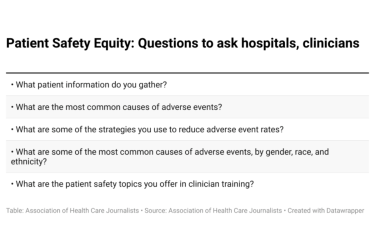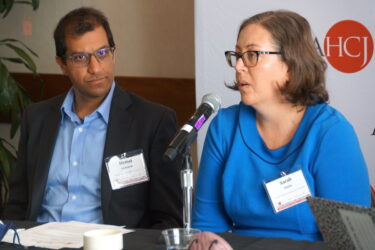
Health Journalism 2016 kicked off a powerful lineup of panels with a roundtable on covering the health angles of cities facing crises. Susan Heavey, who is AHCJ’s topic leader on social determinants and a reporter at Reuters, led the discussion featuring Leana Wen, M.D., health commissioner in Baltimore; Melba Moore, M.S., acting director of health/commissioner of health, City of St. Louis, Abdul El-Sayed, M.D., the executive director and health officer of the Detroit Health Department and Natoya Walker Minor, the acting director of the Cleveland Department of Public Health.
All the panelists work in what they called “legacy cities,” older urban cities that have been under siege with issues that have kept them in the headlines.
Wen, who also is an emergency room physician, addressed the limitations of fighting health disparities, including violence, strictly from inside the hospital walls. It has been almost a year since national media attention focused on Baltimore after Freddie Gray, a 21-year-old African American man, died under mysterious circumstances after being taken into police custody. The city is still reeling from those and other events in the city.
“In Freddie Gray’s neighborhood, the life expectancy is 20 years shorter than it is in other neighborhoods,” Wen said. According to Wen, there is a deep misunderstanding about what is going on in communities. “It is not just about a lot of angry people out there. It is about deep trauma and mental illness.”
She addressed the complications that come with mental health issues. “Four out of 10 incarcerated men in Baltimore are living with mental health issues,” she said. She also addressed the role that poverty plays in causing conflict and poor health outcomes. She said that almost all chronic diseases are related in some way to the social determinants of health.
Moore told the group that homicide is a public health issue and a chronic disease in cities like St. Louis. Her city is still in the national spotlight after Michael Brown, an unarmed black teenager, was shot and killed by a white police officer.
“We need to go in and listen to the community and develop relationships,” Moore said. She added that the media has an important role in helping the conversations on these key public health issues go upstream. “We have to do this together,” she said. Moore noted that public officials and the media are both on the front lines. “We have to work together to come up with common definitions of best practices around these crises.”
In her role as the acting public health officer in Cleveland, Walker Minor said she sees little movement on the health disparities that are causing these crises. “In 1998 Dr. David Satcher released a surgeon general’s report on health disparities. And now, 14 years after he left that job, we are still addressing the same health disparities.”
El-Sayed addressed the environmental health issues that cause health crises in cities such as Detroit and Flint. He said that there is a role for public health research “and then there is the role of media to help to interpret that research. He used southwest Detroit as an example of a community that is plagued by environmental emissions from area refineries. “They are making people sick, ” he said.
The group agreed that the water crisis in Flint is happening in the legacy urban cities with aging infrastructures and older housing stock. “We are dealing with unfunded mandates to fix these systems,” Walker Minor said. She added that there are many conflicting policies on the books in cities that make action difficult.
Moore called for public officials to always tell the truth to the media and communities about what is going on. “So much of what we do is reactive. We all have to get in front of these issues,“ she said.
Wen said that one of the problems is that there is so much focus on cure and little focus on prevention. She cited the Baltimore Safer Streets program run by former gang members. The project mediated 800 conflicts that could have led to violence.
“Six years ago Baltimore had one of the highest infant mortality rates in the country. But thanks to the Baltimore for Healthy Babies Risk Assessment, the rates dropped by 50 percent,” Wen said, illustrating another proactive way to address health disparities.
The panelists agreed that to make real change on these issues there also must be political will. They also expressed the importance of the media’s help in shedding light on these stories.









